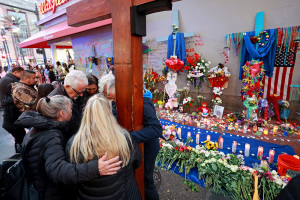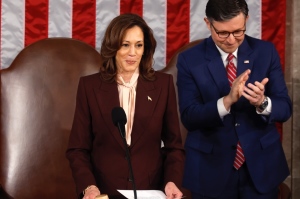Billy Graham: An Icon of American Evangelicalism
The Reverend William (Billy) Graham, 86, is largely seen as the world’s foremost evangelist and the icon of American evangelicalism.
The Reverend William (Billy) Graham, 86, is largely seen as the world’s foremost evangelist and the icon of American evangelicalism. Though often likened to the Biblical Apostle Paul for his fiery preaching, Graham surpassed Paul in sheer numbers of outreach, preaching to more over 210 million people in over 185 countries and territories.
His use of the media, such as television, films, magazines, books, and radio broadcasts, brought millions more to Christ and encouraged them in their faith.
He was published by the Gallup Poll as one of the "Ten Most Admired Men in the World," over 47 times, credited by CBN as America's most respected religious leader, and considered a confidant by every U.S. president since Dwight D. Eisenhower.
Beginnings of Faith
Graham grew up on a small North Carolina dairy farm during the Great Depression and was evangelized by an itinerant preacher, Mordecai Ham, at 16.
He was ordained in 1939 by the Southern Baptist Convention, received Scriptural training at what is now Trinity College in Florida, and graduated from Wheaton College in Illinois.
After graduating, Graham pastored at the First Baptist Church in Western Springs, Ill.. He then became Charter Vice President for Youth for Christ, president of three northwestern schools, and began preaching throughout the United States and in Europe.
Meteoric Rise
In the late 1940s, Graham emerged as a rising evangelist. Since his first official crusade in Augusta, Georgia, in 1948, Graham conducted 417 crusades and numerous smaller-scale meetings.
In Los Angeles the following year, Graham recieved national attention when a three-week crusade extended to eight.
The 1957 New York City crusade, however, is often credited for propelling him to the international limelight. The New York gathering extended from six to 16 weeks while operating at full capacity each night, marking the longest running crusade of his ministry. . Since then, he has held a total of seven New York City crusades, reaching a combined total of 3.2 million people.
His messages during the 1957 New York City crusade were broadcast on television, reaching a national audience.
This masterful use of the media, especially television, was perhaps a reason for his meteoric rise.
Long-time publicist, Larry Ross told NBC, "Mr. Graham is obviously trying to reach as many people as possible with his gospel message.”
Graham founded the Billy Graham Evangelistic Association (BGEA) in 1950, through which he gained access to several media outlets, including: Radio - Graham's weekly "Hour of Decision," radio program broadcast around the world on Sundays for over 50 years; newspaper - Graham's column, "My Answer," is carried by newspapers both nationally and internationally; magazine - The BGEA's official publication, Decision magazine, has a circulation of more than one million, and is translated into German; and film - The BGEA's World Wide Pictures produced and distributed over 125 productions, with films that have been translated into 38 languages and viewed by more than 250 million people worldwide.
Graham's influence also spilled over to ministries outside of the BGEA, including Christianity Today Magazine - which he founded, and the Lausanne Committee on World Evangelism.
Tearing Down the Walls of Segregation
According to Christianity Today, Graham earned the African-American community’s respect as he stood against segregation.
Prior to the 1950s, Graham followed the local custom and preached to mostly segregated audiences in the South and an integrated audience in the North. However, in 1952, he chose to take a stance against segregation, while in the heart of the Deep South: Mississippi.
During his Jackson, Mississippi campaign, Graham walked toward the ropes that separated blacks and whites, and tore them down. Since then, he never again led a segregated campaign.
"There is no scriptural basis for segregation. It may be there are places where such is desirable to both races, but certainly not in the church," Graham told the Mississippi audience. "The ground at the foot of the Cross is level, and it touches my heart when I see whites standing shoulder to shoulder with blacks at the Cross."
Graham backed the civil-rights movement two years prior to the Brown v. Board of Education decision, when "separate but equal" was declared unconstitutional.
In 1957, during the first few nights of the historic 1957 New York crusade, Graham noticed the lack of diversity and the absence of African Americans from his audience. In an effort to reach the city’s minorities, Graham took the message of the Gospel to the heart of the African American community: Harlem. Eight thousand people came out to the first rally there.
One week later at a similar event in Brooklyn, Graham for the first time voiced his support for civil-rights legislation, according to Christianity Today.
Graham befriended the late Martin Luther King Jr., and the two shared dreams of conducting joint evangelistic crusades. While Graham and King parted over disagreements on civil disobedience, they remained in contact with one another.
Graham invited King to give a prayer at meetings, a “symbolic move that further solidified his commitment to the movement toward racial equality.”
Proclaiming the Gospel of Love
An icon of American evangelicalism, Graham wrought testimonies even from would-be critics.
"He made America safe for public testimonies of faith," wrote Time Magazine which profiled him in the Time 100 issue as one of the century's most important people. "It seems legitimate to conclude that his almost exclusive emphasis upon soul saving is his passionate center", testified Time.
Graham's message was often simple: God loves man and His love for man is revealed through Jesus Christ.
According to the BGEA, Graham said: "My one purpose in life is to help people find a personal relationship with God, which, I believe, comes through knowing Christ."
Graham stayed true to preaching the love of God and the infallibility of the word of God.
"We are called to be steadfast for Christ and his truth, regardless of the situation. Our calling is not to be successful (as the world measures success); our calling is to be faithful," wrote Graham in 1996 as founder and editor of Christianity Today.
He and his wife, Ruth, have three daughters, two sons, 19 grandchildren and numerous great grandchildren, and make their home in the mountains of North Carolina.





























